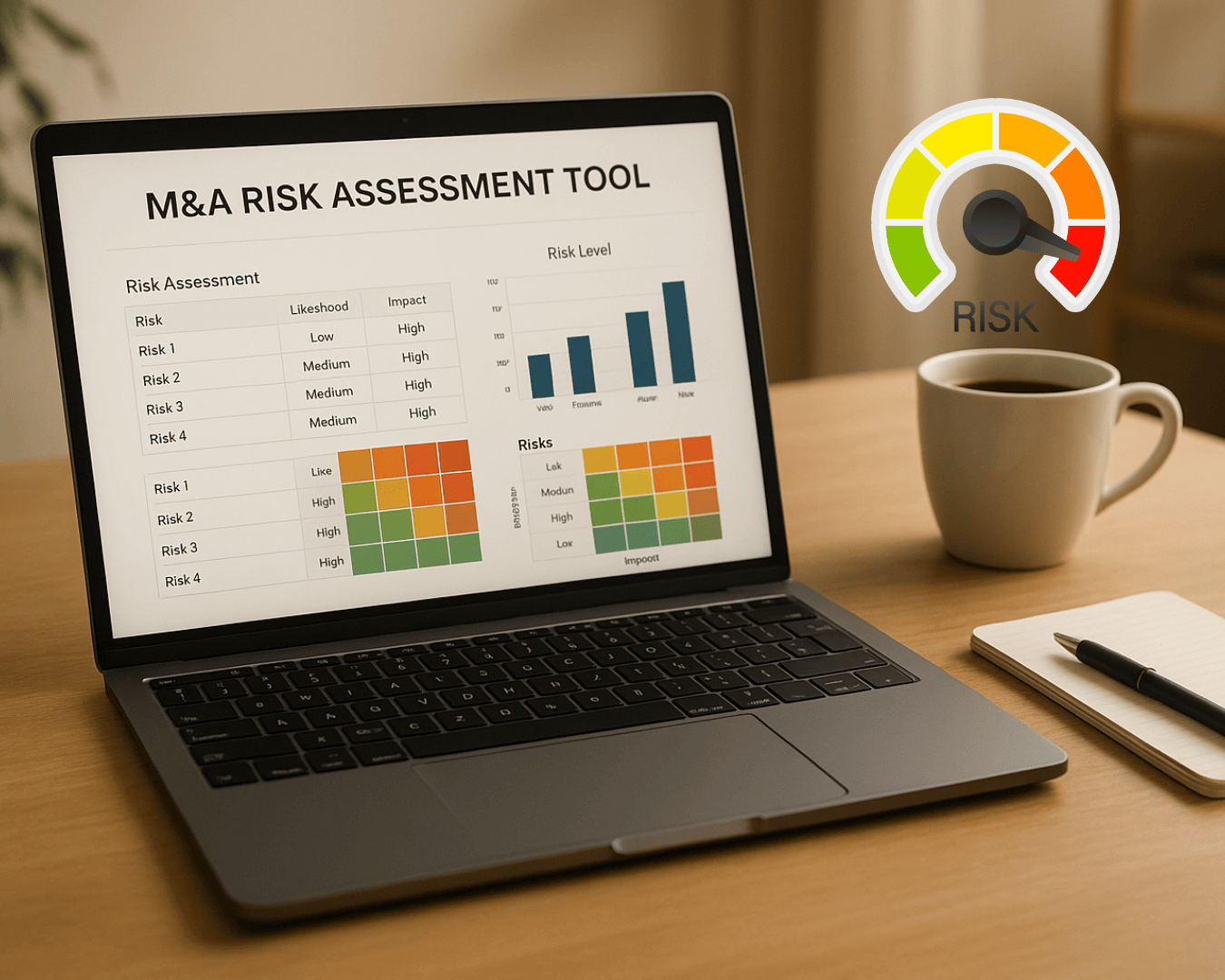Scenario analysis is a structured way to forecast how different scenarios - best, base, and worst cases - might impact revenue after a merger or acquisition. It helps buyers and sellers plan for uncertainties like market changes, customer retention, or integration costs. By modeling multiple outcomes, this method reduces risk, supports fair valuations, and ensures smarter decision-making.
Here’s why it matters:
- Better risk management: Understand potential revenue swings and prepare for setbacks.
- Valuation clarity: Helps bridge gaps between buyers and sellers, especially with tools like earnouts.
- Small business focus: Essential for Main Street and lower mid-market deals where resources and data are limited.
Key steps include:
- Define scenarios: Base (most likely), upside (optimistic), and downside (pessimistic).
- Identify revenue drivers: Customer acquisition, pricing strategies, and synergies.
- Use probability weighting: Assign likelihoods (e.g., 60% base, 25% downside, 15% upside) to refine forecasts.
- Leverage tools: AI platforms simplify data collection and scenario modeling.
Scenario analysis isn’t about predicting the future - it’s about preparing for it. By combining data, expert advice, and clear assumptions, you can make informed decisions throughout the M&A process.
Core Components of Scenario Analysis for Revenue Projections
Base Case, Upside Case, and Downside Case Scenarios
Creating effective revenue projections requires considering three key scenarios: Base Case, Upside Case, and Downside Case. Each serves a distinct purpose in forecasting and helps prepare for a range of possibilities.
The Base Case represents the most likely outcome, relying on current trends and historical data. The Upside Case assumes favorable conditions, like achieving full synergies or expanding into new markets. Meanwhile, the Downside Case accounts for potential setbacks, such as integration challenges or economic downturns.
For instance, a Base Case might predict revenue growth consistent with past performance. An Upside Case could envision accelerated growth fueled by initiatives like cross-selling or entering untapped markets. On the other hand, the Downside Case might anticipate stagnation or even decline due to increased competition or unfavorable market conditions.
This three-scenario framework is invaluable because it prepares stakeholders for different outcomes rather than relying on a single projection. This is especially important when considering that only 23% of mergers achieve their projected revenue synergies.
| Scenario Type | Description | Typical Assumptions | Primary Use |
|---|---|---|---|
| Base Case | Most likely outcome based on current trends | Stable market conditions, historical growth rates | Standard planning and budgeting |
| Upside Case | Optimistic scenario with favorable conditions | Successful synergies, market expansion | Evaluating best-case potential |
| Downside Case | Pessimistic scenario with adverse conditions | Integration delays, market decline | Risk management and contingency planning |
Finding Revenue Drivers
Once you've outlined the scenarios, the next step is identifying the key factors that drive revenue. These drivers - like customer acquisition, pricing strategies, and operational synergies - are the backbone of accurate forecasting.
- Customer acquisition: For businesses with recurring revenue models, acquisition rates are often a primary driver. Understanding how a merger might impact the ability to attract new customers is crucial for setting realistic growth expectations across all scenarios.
- Pricing strategies: Mergers can create opportunities for premium pricing, especially if the combined entity offers enhanced services or gains a stronger market position. Additionally, cross-selling complementary products or services to an expanded customer base can significantly boost revenue.
- Operational synergies: These include improved distribution and market reach. In the Upside Case, you might assume full realization of these synergies, while the Base Case uses more conservative estimates, and the Downside Case considers minimal or delayed benefits.
It’s essential to prioritize the revenue drivers that have the greatest impact and are most sensitive to change. For example, a subscription-based business might focus on customer retention, while a product-driven company might emphasize volume growth and pricing adjustments. Historical financial data, market research, and industry benchmarks are critical tools for pinpointing these drivers.
Once the drivers are clear, assigning probabilities to different scenarios ensures a more accurate and nuanced forecast.
Using Probability Weighting
Probability weighting is a practical tool to refine scenario analysis. By assigning realistic likelihoods to each scenario, you can create a more balanced and comprehensive revenue forecast. For example, you might assign a 60% probability to the Base Case, 25% to the Downside Case, and 15% to the Upside Case.
This method generates a weighted average forecast, offering a more realistic picture of potential revenue outcomes. It’s particularly useful for communicating with stakeholders - like investors and lenders - who need to understand both the expected results and the associated risks.
Probability weighting is especially valuable in Main Street and lower mid-market deals, where uncertainty is higher, and historical data may be limited. By incorporating expert opinions and data from comparable transactions, buyers and sellers can set more realistic expectations and structure deals that balance risk and reward appropriately.
Additionally, this approach supports sensitivity analysis, helping stakeholders see how changes in key assumptions - like customer acquisition rates or pricing - affect the overall revenue projection. This dynamic framework not only improves decision-making but also highlights the factors most critical to post-merger success.
How to Create a Mergers and Acquisitions Model with Excel Template (Step-by-Step Tutorial)

Step-by-Step Guide to Conducting Scenario Analysis
Now that we've covered revenue drivers and scenario components, let’s walk through the process of conducting scenario analysis in M&A. Creating accurate revenue projections requires a structured approach to data analysis and strategic modeling.
Analyzing Historical Data and Market Trends
The foundation of any solid scenario analysis starts with digging into the historical financials of both companies. This means reviewing several years’ worth of income statements, balance sheets, and cash flow statements. Look for patterns like seasonality, growth rates, and changes in market share. Be sure to adjust for any one-time events to keep your analysis consistent and reliable.
Market trends are just as important. Regulatory changes, economic cycles, and shifts in the competitive landscape all play a role in shaping realistic scenarios. Comparing key performance metrics with industry benchmarks can validate your assumptions. Breaking down revenue by product line, customer segment, or geography will reveal which areas contribute the most value and should be prioritized.
Once you’ve established these historical trends, the next step is to assess potential synergies and integration effects.
Modeling Synergies and Integration Effects
With a clear understanding of past performance, it’s time to estimate the benefits and challenges of combining the two businesses. Cost-saving synergies, such as removing duplicate roles or consolidating facilities, are often the easiest to predict. For your base case, stick with conservative estimates. For the upside scenario, you might assume quicker savings, while the downside scenario should factor in delays or incomplete results.
Revenue synergies, on the other hand, can be trickier to model. Opportunities like cross-selling, broader distribution channels, or improved market positioning can boost growth, but they often take time to realize. Integration challenges - such as customer churn, sales team distractions, or system disruptions - can also temporarily impact revenue. Don’t forget to account for one-time integration costs and early ramp-up periods. Using examples from similar past transactions can help validate your assumptions.
Once you’ve modeled these synergies, advanced tools can help refine your projections even further.
Using Advanced Tools and AI
Modern M&A processes increasingly rely on advanced tools to enhance scenario accuracy. AI-powered platforms can automate data collection, identify key revenue drivers, and generate multiple scenarios - all while minimizing manual errors.
Companies that incorporate advanced analytics into their scenario analysis are 30% more likely to meet their performance goals. The ability to update scenarios as new information emerges leads to better projections and smarter decisions throughout the M&A process.
sbb-itb-a3ef7c1
Best Practices and Common Limitations in Scenario Analysis
Scenario analysis plays a pivotal role in shaping M&A outcomes, even when using the best tools and data. Knowing what strategies work - and recognizing potential pitfalls - helps buyers and sellers navigate the complexities of revenue projections more effectively.
Best Practices for Effective Scenario Analysis
Successful M&A teams understand that scenario analysis isn’t a one-time activity. It requires constant updates and refinements throughout the deal lifecycle. This includes revisiting scenarios during due diligence, integration planning, and post-close monitoring.
Another key to success is integrating diverse data sources. Combining internal historical data with external insights - like market research, industry trends, and real-time economic indicators - leads to stronger, more reliable scenarios. For instance, blending company-specific sales data with broader industry growth rates can validate revenue projections and uncover risks or opportunities that might otherwise go unnoticed.
Instead of overloading models with countless variables, focus on 3–5 factors that have the greatest impact on revenue outcomes. This keeps the analysis manageable and actionable. Additionally, clearly documenting assumptions ensures all stakeholders are aligned and on the same page.
As the deal progresses, it’s crucial to refine these assumptions by incorporating feedback from real-world developments. This iterative approach not only keeps projections relevant but also helps teams prepare for a variety of market conditions, enhancing financial resilience.
Even with these best practices, challenges are inevitable.
Common Challenges and Limitations
Scenario analysis, despite its value, comes with its own set of obstacles. One of the most pressing issues is data accuracy. Incomplete or inconsistent data can lead to flawed projections, undermining decision-making. For M&A practitioners, ensuring data reliability is often easier said than done.
Another major hurdle is forecasting uncertainty. Market dynamics, regulatory shifts, or unexpected operational disruptions can cause actual outcomes to diverge sharply from projections. This is particularly true in M&A, where the success of integration synergies and organizational alignment is difficult to quantify and may not unfold as planned.
The complexity of modeling integration impacts adds another layer of difficulty. Challenges like system incompatibilities, cultural differences, or delays in synergy realization can inflate costs and reduce expected revenue gains. For example, if cross-selling opportunities are delayed due to integration hiccups, revenue growth may fall short of initial projections.
| Challenge Type | Common Issues | Potential Impact |
|---|---|---|
| Data Accuracy | Incomplete data, inconsistent sources | Misleading projections, poor decisions |
| Forecasting Uncertainty | Market shifts, regulatory changes | Significant deviation from scenarios |
| Integration Complexity | System incompatibilities, cultural clashes | Delayed synergies, higher costs |
These challenges highlight a critical point: scenario analysis is not about predicting the future with absolute certainty. Instead, it’s about preparing for a range of potential outcomes, identifying key decision points, and monitoring early warning signals to adapt as conditions evolve.
Conclusion: The Role of Scenario Analysis in M&A Success
Scenario analysis has become an essential tool for navigating the complexities of mergers and acquisitions (M&A). By modeling a variety of financial outcomes instead of relying solely on single-point forecasts, businesses can fine-tune their strategies and make more informed decisions.
Key Takeaways
Here’s what stands out:
- Companies that incorporate scenario analysis into their M&A processes are 30% more likely to hit post-merger revenue targets compared to those relying on single-point forecasts. This approach allows deal teams to account for a wide range of outcomes, from conservative estimates to ambitious growth scenarios.
- Scenario analysis enhances risk management by proactively identifying potential challenges. For example, it can model the impact of integration delays, market shifts, or customer retention issues. This is especially critical for smaller businesses, where unexpected revenue drops can severely affect operations and cash flow.
- For smaller transactions - such as those involving Main Street or lower mid-market businesses - scenario analysis is particularly valuable. These companies often rely on a handful of customers, seasonal trends, or specific local markets, making their revenue streams more unpredictable. Scenario analysis helps capture these nuances and assess their potential effects on post-acquisition performance.
As discussed earlier, having a clear framework and the right tools is key to achieving successful results.
Next Steps for Business Buyers and Sellers
To put these insights into action, consider the following steps:
- Identify and document key revenue drivers. Focus on 3–5 critical factors, using 3–5 years of historical data to build accurate projections. Regularly update assumptions as new information becomes available.
- Use a reliable platform to simplify the process. Clearly Acquired offers AI-powered tools that tackle common challenges like data accuracy and integration complexity. With access to over 100,000 verified public listings and data on 200 million off-market businesses, the platform provides the intelligence needed for effective scenario modeling.
- Incorporate scenario analysis throughout the M&A process. Don’t limit it to the valuation phase. Use scenarios to guide decisions on earn-outs, price adjustments, and integration planning. The insights gained should shape every major step of the transaction.
- Seek expert advice when needed. Areas like tax strategies, financing structures, and integration planning can be tricky to navigate. Clearly Acquired’s advisory network offers real-time support, helping businesses make informed choices that align with their scenario analysis.
The M&A world continues to evolve, with data-driven strategies taking center stage. Companies that embrace scenario analysis - backed by the right tools and expert guidance - are better equipped to achieve successful outcomes in their next deal.
FAQs
How does scenario analysis help manage risks in M&A revenue forecasting?
Scenario analysis plays a key role in improving risk management during M&A revenue forecasting. By examining various potential outcomes and their effects on revenue projections, this method helps pinpoint risks tied to operations, finances, regulations, and workforce dynamics early in the process.
Using insights grounded in data, businesses can make smarter decisions, adapt strategies ahead of time, and increase their chances of achieving lasting success in mergers and acquisitions.
What key factors should be analyzed to project revenue in mergers and acquisitions?
To estimate revenue accurately during mergers and acquisitions, it's crucial to examine the main revenue drivers that influence financial performance. These drivers include elements like market demand, customer retention rates, pricing strategies, competitive positioning, and any potential synergies that could arise from combining the two entities.
Using scenario analysis can provide valuable insights into possible revenue outcomes. By modeling different assumptions - such as shifts in market conditions or improvements in operational efficiency - you can make better-informed decisions and minimize risks during the transaction process.
How do AI tools improve scenario analysis for revenue projections in M&A transactions?
AI tools play a key role in improving the accuracy and dependability of scenario analysis during mergers and acquisitions. By quickly processing massive datasets and spotting patterns that might escape human attention, these tools bring a new level of precision to the table. They can simulate a range of revenue outcomes under different scenarios, equipping stakeholders with the insights they need to make well-informed choices.
Take platforms like Clearly Acquired, for instance. They use advanced AI technology to simplify due diligence, enhance financial modeling, and deliver actionable insights. This allows buyers, sellers, and investors to confidently predict outcomes and navigate the M&A process more efficiently, leading to smarter and more strategic decisions.








































.png)








































%20Loan%20Application%20Checklist.png)




























